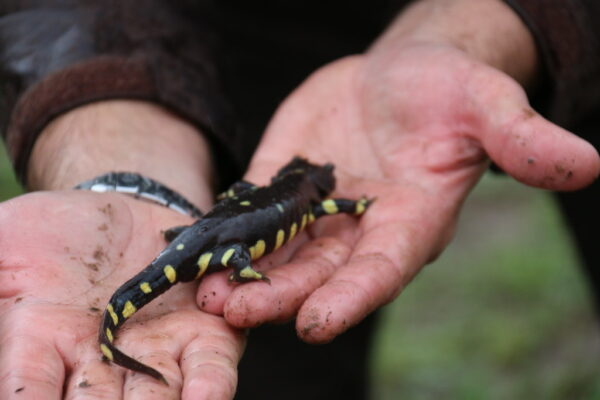Scientific Name: Ambystoma tigrinum
Physical Traits
- Size: Large salamander, reaching lengths of 6-14 inches (15-36 cm)
- Color: Dark brown or black with yellow or olive-green markings resembling tiger stripes
- Body Structure: Stocky body with a broad head, sturdy legs, and a long tail
- Adaptations: Well-developed lungs for terrestrial life, and smooth skin to retain moisture
Life Span
- In the Wild: Up to 15 years
- In Captivity: Up to 25 years
Habitat
- Geographical Range: Throughout North America, from southern Canada to Mexico
- Preferred Environment: Woodlands, grasslands, and semi-aquatic areas near ponds, lakes, or slow-moving streams
Diet
- Main Food Source: Carnivorous, feeding on insects, worms, small fish, and other invertebrates
- Foraging Behavior: Active hunters, using their keen sense of smell to locate prey
Reproduction
- Breeding Season: Late winter to early spring, with some variation depending on local climate
- Eggs: Females lay up to 1,000 eggs, which are attached to submerged vegetation or other underwater structures
- Larval Stage: Aquatic, with gills for breathing; metamorphose into terrestrial adults after several months
Conservation Status
- IUCN Red List: Least Concern (LC) overall, but some subspecies are considered threatened or endangered
- Population Trend: Stable in many areas, but declining in some regions due to habitat loss, pollution, and disease
Interesting Facts
- Mole Salamanders: Tiger salamanders belong to the family Ambystomatidae, also known as mole salamanders, due to their burrowing habits
- Neotenic Forms: In some populations, individuals retain their larval features and remain aquatic throughout their lives, a condition known as neoteny
- Environmental Indicators: Tiger salamanders are considered indicator species, as their presence reflects the overall health of their ecosystem
- Predators: Birds, snakes, and other large predators are among the main threats to tiger salamanders
- Regeneration: Tiger salamanders possess the ability to regenerate lost limbs and other body parts


